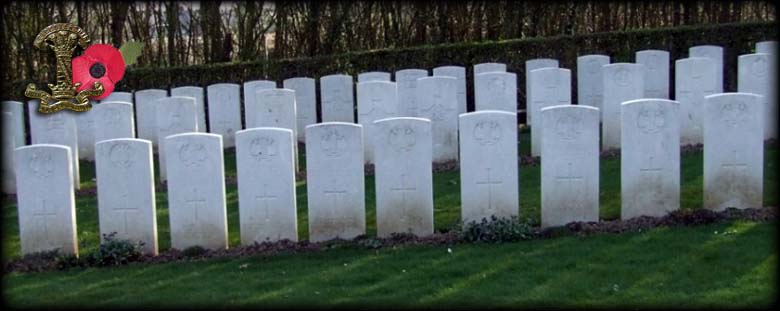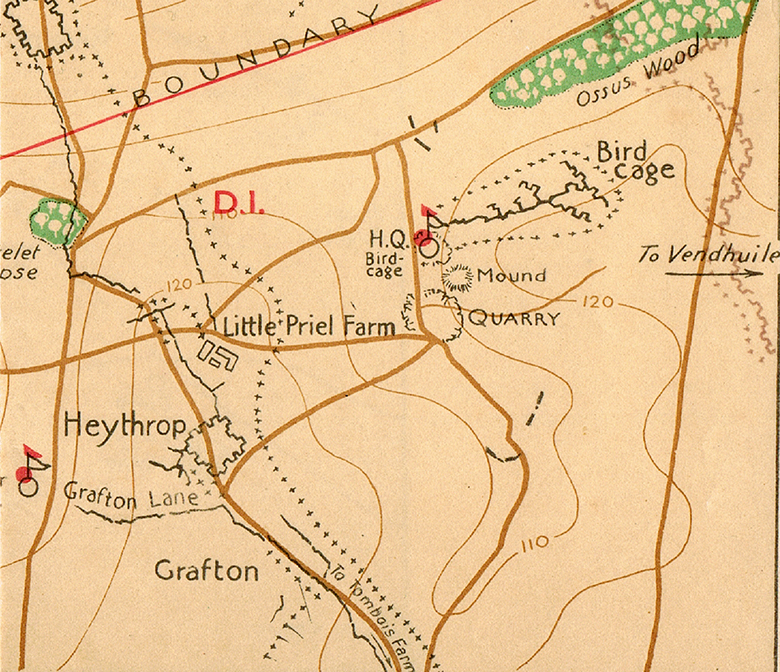|
The Birdcage
The 1/1st Leicestershire Yeomanry served on the
Western Front as a unit from November 1914 to March 1918, from
April 1918 to the Spring of 1919 the Regiment's three squadrons
were allocated to the Regiments of the 3rd Cavalry
Brigade. During their service on the Western Front the Regiment
suffered many casualties but there were only two occasions when
the Regiment sustained substantial fatalities, both involved
attacks by German troops on trenches they held. The first is
well known, The Battle of Frezenberg in May 1915, when 93 men
died, the second took place in June 1917 resulted in 10
fatalities and is probably less well known. Neither figure
includes those who subsequently died of their wounds.
Unfortunately the 'Outline History of the Leicestershire
Yeomanry', which was written by an officer who served with the
Regiment during WWI, only provides a passing reference to the
action in June 1917. The entry records 'in spite of several
casualties suffered through a determined German raid …........
it was with regret that they [the Regiment] finally left this
sector'. Fortunately the space saved is not wasted as three
paragraphs were needed to record a boar hunt. It is of interest
that both the history of the 10th Hussars and the
Essex Yeomanry and the history of the 6th Cavalry
Brigade refer to the raid on the Leicestershire Yeomanry in more
detail. A benefit
of the mention, albeit brief, in the 'Outline History' is that
former Lance Corporal John E. Smith, who was involved in the
action, wrote to the author and his letter is preserved in the
Records Office.
In June 1917, whilst the Regiment was located in Tincourt, along
with other Regiments of the 3rd Cavalry Division it
was required to provide a dismounted party to take over part of
the front in Epehy overlooking the Canal de St. Quentin, this
was known as D1 sub-sector. This part of the front included The
Quarries and an exposed outpost line known as The Birdcage,
which could only be approached at night. On the night of the 21st
June one troop from B Squadron and three troops from C Squadron
relieved the 10th Hussars in The Birdcage. Upon
completion of the relief Lieutenant Toulmin (Sniping Officer),
Sergeant Talbot and a party of snipers went into No Man's Land
to patrol towards the German sap. It seems that Lt. Toulmin saw
German troops moving and the patrol started to return to The
Birdcage but was caught in a German trench mortar barrage fired
as part of a trench raid. The Regiment's War Diary records that
Lt Toulmin and four members of the patrol were killed, Lcpl
Smith records that three members of the patrol survived with one
of them being wounded
and reaching the trench but then being buried and having
to be dug out. Smith also refers to the barrage killing all his
section and the need to maintain steady fire to stop the Germans
from entering the trench. The History of the 6th
Cavalry Brigade records that one party of the attacking Germans
was driven off by rapid fire, the other was caught by their own
trench mortar barrage. 'Friendly Fire' or 'Blue on Blue' is not
a new concept.

( 9 graves of the men shown, Lt Toulmin's is in a row
toward the rear).
**On the 22/06/1917,
Lt. Toulmin with Sgt. Talbot, Cpl. Knight, Tpr(s) Rhodes,
Howard, Lester, Green, Dormer, Huss were all killed in one
action, and Tpr. Rowe died of his wounds on the next day. All
are buried at the VILLERS-FAUCON COMMUNAL CEMETERY with the
exception of Tpr. Rowe who is at TINCOURT NEW BRITISH CEMETERY. Here
is a letter describing what happened that night at 1:30 a.m.
The Regiment's War Diary records that the casualties were one
officer and nine other ranks killed and ten other ranks wounded.
Lcpl Smith was one of the wounded but, luckily, he was able to
rejoin the Regiment within six days.
Understandably there are no references to the number of German
casualties caused by the trench mortar barrage. In respect of
the casualties caused by the rapid rifle fire there are
conflicting accounts. There would appear to have been ten
killed, with their bodies left on the wire but, as to the number
wounded, one account has three wounded being brought into the
trench, all subsequently dying. Another records that a German
officer was killed trying to enter the trench, with three
prisoners taken, two of whom were severely wounded and died.
The ten members of the Leicestershire Yeomanry who were killed
in this action were Lt Toulmin, Sgt Talbot, Cpl Knight and
Privates Donner, Green, Hart, Howard, Huss, Lester and Rhodes,
all of whom are buried in Villers-Faucon Communal Cemetery. Pte
Rowe died of wounds on the 27th June and is buried in
Tincourt New British Cemetery. It is possible he was of the ten
other ranks wounded in the action and died having been taken to
one of the five Casualty Clearing Stations located in the
Tincourt area.
On the 17th June members of the 8th
Cavalry Brigade (Royal Horse Guards, 10th Hussars and
Essex Yeomanry) had carried out a raid on the German trenches,
one of the aims being to identify the unit occupying the trench.
Whilst their raid did cause casualties amongst those holding the
trench, it did not result in the unit being identified. However,
the three wounded Germans who were brought into the trench
defended by the Leicestershire Yeomanry did result in their unit
being identified and a further planned raid was cancelled.

|